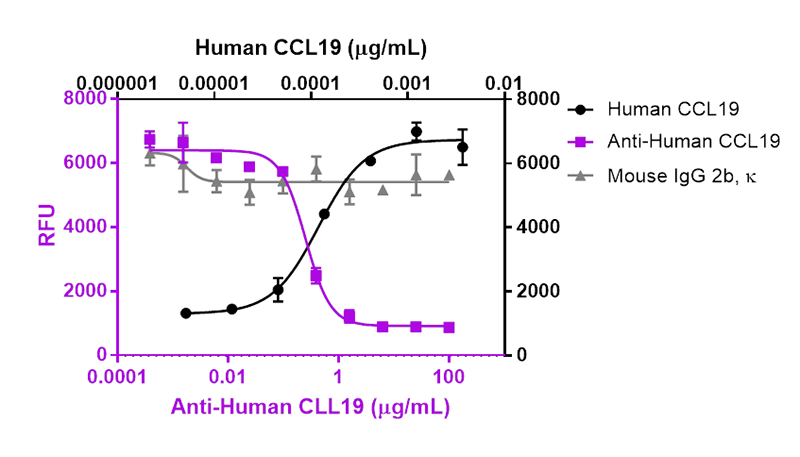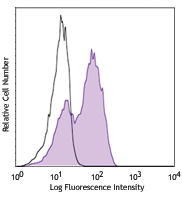- Clone
- BVD10-40F6 (See other available formats)
- Regulatory Status
- RUO
- Other Names
- Interleukin-7, Lymphopoietin-1 (LP-1), Pre-B cell growth factor, Thymocyte growth factor
- Isotype
- Rat IgG1, κ
- Ave. Rating
- Submit a Review
- Product Citations
- publications

| Cat # | Size | Price | Quantity Check Availability | Save | ||
|---|---|---|---|---|---|---|
| 501305 | 100 µg | $270 | ||||
| 501306 | 1 mg | $743 | ||||
IL-7 is a potent lymphoid cell growth factor which promotes the proliferation of pre-B cells, thymocytes, T cell progenitors, and mature T cells. IL-7 induces formation of LAK cells and CTLs, and can stimulate tumoricidal activity of monocytes and macrophages. IL-7 can induce upregulation of proinflammatory cytokines in myeloid cells. IL-7 is expressed by stromal cells. The BVD10-40F6 antibody can neutralize the bioactivity of natural or recombinant IL-7.
Product DetailsProduct Details
- Verified Reactivity
- Human
- Antibody Type
- Monoclonal
- Host Species
- Rat
- Immunogen
- E. coli - expressed, recombinant human IL-7
- Formulation
- 0.2 µm filtered in phosphate-buffered solution, pH 7.2, containing no preservative.
- Endotoxin Level
- Less than 0.01 EU/µg of the protein (< 0.001 ng/µg of the protein) as determined by the LAL test.
- Preparation
- The Ultra-LEAF™ (Low Endotoxin, Azide-Free) antibody was purified by affinity chromatography.
- Concentration
- The antibody is bottled at the concentration indicated on the vial, typically between 2 mg/mL and 3 mg/mL. Older lots may have also been bottled at 1 mg/mL. To obtain lot-specific concentration and expiration, please enter the lot number in our Certificate of Analysis online tool.
- Storage & Handling
- The antibody solution should be stored undiluted between 2°C and 8°C. This Ultra-LEAF™ solution contains no preservative; handle under aseptic conditions.
- Application
-
ELISA Capture - Quality tested
ELISPOT Capture, Neut, WB - Reported in the literature, not verified in house - Recommended Usage
-
Each lot of this antibody is quality control tested by ELISA assay. For ELISA or ELISPOT capture applications, a concentration range of 2.0 - 6.0 µg/mL is recommended. To obtain a linear standard curve, serial dilutions of IL-7 recombinant protein ranging from 500 to 4 pg/ml are recommended for each ELISA plate. It is recommended that the reagent be titrated for optimal performance for each application.
- Application Notes
-
ELISA or ELISPOT Capture1,2: The purified BVD10-40F6 antibody is useful as the capture antibody in a sandwich ELISA or ELISPOT assay, when used in conjunction with the Biotin anti-human IL-7 antibody (Cat. No. 506602) as the detecting antibody. The Ultra-LEAF™ purified antibody is suggested for ELISPOT capture.
Neutralization1: The Ultra-LEAF™ purified antibody (Endotoxin <0.01 EU/µg, Azide-Free, 0.2 µm filtered) is recommended for neutralization of human IL-7 bioactivity (Cat. No. 501305 & 501306).
Additional reported applications (for the relevant formats) include: Western blotting. -
Application References
(PubMed link indicates BioLegend citation) -
- Abrams J, et al. 1992. Immunol. Rev. 127:5.
- Abrams J. 1995. Curr. Prot. Immunol.. John Wiley and Sons New York. Unit 6.20.
- RRID
-
AB_2861028 (BioLegend Cat. No. 501305)
AB_2861029 (BioLegend Cat. No. 501306)
Antigen Details
- Structure
- Cytokine; 20-28 kD (Mammalian)
- Bioactivity
- Proliferation of pre-/pro-B cells, thymocytes, T cells; formation of LAK cells, CTLs, stimulation of tumoricidal activity monocytes/macrophages; upregulate proinflammatory cytokines in myeloid cells
- Cell Sources
- Adherent bone marrow stromal cells, thymic stromal cells, spleen, keratinocytes
- Cell Targets
- Progenitor B and T cells; CD4-CD8- thymocytes; megakaryocytes
- Receptors
- Heterodimer IL-7Rα (CD127); γ-subunit (CD132) in common with IL-2R, IL-4R, IL-13R, IL-15R
- Biology Area
- Immunology
- Molecular Family
- Cytokines/Chemokines
- Antigen References
-
1. Fitzgerald K, et al. Eds. 2001. The Cytokine FactsBook. Academic Press San Diego.
2. Park L, et al. 1992. Adv. Exp. Med. Biol. 323 125.
3. Melchers F, et al. 1992. Adv. Exp. Med. Biol. 323 111. - Regulation
- Downregulated by TGF-β
- Gene ID
- 3574 View all products for this Gene ID
- UniProt
- View information about IL-7 on UniProt.org
Related FAQs
- Do you guarantee that your antibodies are totally pathogen free?
-
BioLegend does not test for pathogens in-house aside from the GoInVivo™ product line. However, upon request, this can be tested on a custom basis with an outside, independent laboratory.
- Does BioLegend test each Ultra-LEAF™ antibody by functional assay?
-
No, BioLegend does not test Ultra-LEAF™ antibodies by functional assays unless otherwise indicated. Due to the possible complexities and variations of uses of biofunctional antibodies in different assays and because of the large product portfolio, BioLegend does not currently perform functional assays as a routine QC for the antibodies. However, we do provide references in which the antibodies were used for functional assays and we do perform QC to verify the specificity and quality of the antibody based on our strict specification criteria.
- Does BioLegend test each Ultra-LEAF™ antibody for potential pathogens?
-
No, BioLegend does not test for pathogens in-house unless otherwise indicated. However, we can recommend an outside vendor to perform this testing as needed.
- Have you tested this Ultra-LEAF™ antibody for in vivo or in vitro applications?
-
We don't test our antibodies for in vivo or in vitro applications unless otherwise indicated. Depending on the product, the TDS may describe literature supporting usage of a particular product for bioassay. It may be best to further consult the literature to find clone specific information.
Other Formats
View All IL-7 Reagents Request Custom Conjugation| Description | Clone | Applications |
|---|---|---|
| Purified anti-human IL-7 | BVD10-40F6 | ELISA Capture |
| Ultra-LEAF™ Purified anti-human IL-7 | BVD10-40F6 | ELISA Capture,ELISPOT Capture,Neut,WB |
Customers Also Purchased
Compare Data Across All Formats
This data display is provided for general comparisons between formats.
Your actual data may vary due to variations in samples, target cells, instruments and their settings, staining conditions, and other factors.
If you need assistance with selecting the best format contact our expert technical support team.
 Login/Register
Login/Register 

















Follow Us